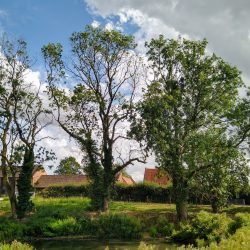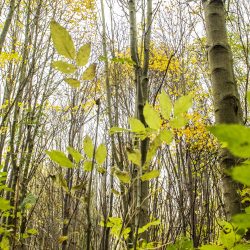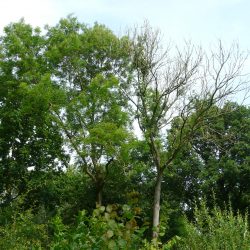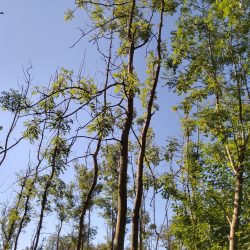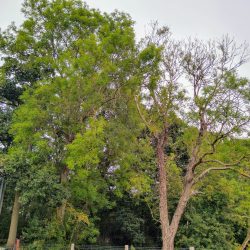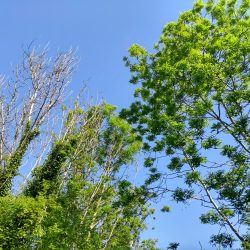Ashes from ashes
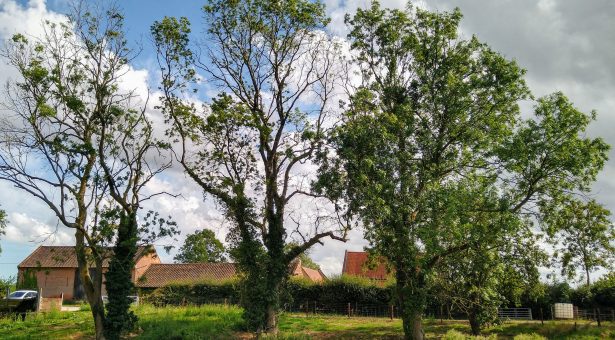
Professor James Brown and Dr Elizabeth Orton draw lessons from plant breeding in crops to propose that natural selection for resistance to ash dieback can be accelerated.
Ash dieback is becoming increasingly obvious and widespread throughout the UK. Many ash (Fraxinus excelsior) trees have already been felled although few mature have yet been killed outright by dieback, and the loss of many large, established trees will damage the landscape, biodiversity, ecosystem services and hardwood timber production.
The tone of much commentary on this disease might suggest that ash in Europe is doomed. Here, by contrast, we explain how the progress of ash dieback in Norfolk, one of the most heavily affected counties, points to good prospects for long-term recovery of ash in the UK and Europe generally.
In particular, we ask what lessons from successful breeding of disease-resistant crop varieties can be applied to promoting the revival of ash by accelerating natural selection for dieback-resistance.
Ecology and epidemiology of ash dieback
Our moderately optimistic outlook is based on the ecology and epidemiology of ash dieback and on growing knowledge of the genetics of disease resistance.
The fungal pathogen, Hymenoscyphus fraxineus (formerly known as Chalara fraxinea and H. pseudoalbidus), can be transported over long distances in infected planting stock and may have arrived in north-east Europe from east Asia in this manner (Drenkhan et al., 2014).
Locally, H. fraxineus is dispersed from ascocarps, fruiting bodies formed by sexual reproduction on rachises of leaves that fell the previous year (Figure 1). Most ascospores do not move far but a small minority are blown on the wind over long distances.
Population genetic data indicate that H. fraxineus arrived in the UK in both ways (Orton et al., 2017). Together with local spore dispersal, this has produced the current situation where ash dieback is present in the wider environment of every county in the UK but is generally most severe in the east, where ascospores have been wind-dispersed from the continent.
The development of ash dieback is strongly affected by environmental conditions. It is promoted by damp sites with deep fertile soil, little wind and a high density of ash trees (see Chumanova et al., 2019, reporting a study of forests throughout the Czech Republic; also Skovsgaard et al., 2017).
This corresponds closely to our observations in Norfolk, where the most heavily affected sites have dense stands of ash in damp locations (as in Figure 2e), whereas dry, well-drained, exposed sites with only a few ash trees tend to have little dieback.
Although H. fraxineus disperses rapidly over long distances, the progress of ash dieback in an infected tree can be slow, with mature trees surviving at least 10 years after first becoming infected (Skovsgaard et al., 2017; Wylder et al., 2018).
The fungus grows quickly in young trees and immature stems, so saplings may succumb within a couple of years, but the disease develops slowly in mature wood.
Although ash dieback was first observed in the UK in 2012, it had been present for many years previously, at least since 2004 and possibly as early as 1992 (Wylder et al., 2018).
While only a small fraction of mature ash has been killed outright so far (Coker et al., 2019), many trees in the worst affected counties, including Norfolk, have become diseased to the point where they now have limited value for amenity, wildlife or timber.
Variation in ash dieback resistance
There is wide variation in the amount of dieback that develops in individual ash trees, even those close to each other.
As usual in plant disease, variation in resistance to ash dieback is continuous, without a sharp distinction between resistant and susceptible individuals.
Statements to the effect that a certain percentage of trees are resistant can be misleading because the figure depends on how greatly the local environment stimulates ash dieback symptoms and how much damage is considered acceptable.
Nevertheless, across northern Europe, a consistent proportion of 5-10% of trees have worthwhile resistance, in the sense that they have much less damage from ash dieback than the local average.
It is easy to find trees that may have genetic resistance to ash dieback. The critical point is to ask if a tree is much less diseased than others nearby of a similar size and age. Differences even between neighbouring trees can be striking; in many places in Norfolk, we have seen such local contrasts persisting for five years or more.
The easiest time of year to see this variation is in late summer and early autumn when dieback symptoms on leaves and twigs are at their peak.
Inspection of the bark in winter can also be helpful. In principle, experimental analysis is needed to test if the variation observed is genetic but given the high exposure of ash in Norfolk to the fungus, it is likely that trees that are significantly healthier than others nearby have more effective resistance genes, and that such contrasts do not result merely from fine-scale variation in environmental conditions.
The ability to identify candidate resistant trees depends on the local severity of ash dieback. Variation in symptoms is most obvious where the disease has become firmly established but is not yet devastating. This reflects the experience of breeding crops, where it is easiest to select varieties with greater disease resistance in trials where there are wide differences between susceptible and resistant lines.
At moderately affected sites in Norfolk, we usually find some trees that are obviously much healthier than most others. Even at the most severely diseased sites, a few trees have retained noticeably more of their canopy than the majority although the differences are not so obvious.
Knowledge of the history of a site may be helpful, especially when trees with the most severe dieback have died or been removed so those remaining may have some resistance. By contrast, at sites with little disease where most or all trees are healthy, one cannot confidently identify individuals which may be genetically resistant.
Genetics of ash dieback
Reduced susceptibility to ash dieback is a complex trait with diverse phenotypes involving disease resistance, disease escape and tolerance of the pathogen.
From published research (McKinney et al., 2011, 2012; Gross et al., 2016; Orton et al., 2019) and our own field observations, resistance can be expressed in many ways: a lower rate of lesion formation by ascospores, slower growth of lesions following infection of the leaflet blade, slower growth of the fungus through the rachis and in infected branches, callousing of infected bark which prevents further fungal penetration into healthy wood, and continued vigorous growth of healthy stems despite other parts of the tree being infected (not to be confused with epicormic growth from buds under the bark near a canker).
Disease escape occurs when the form or timing of a plant’s growth or development limits infection or disease.
In ash dieback earlier leaf fall has been associated with lower susceptibility, possibly because it restricts the opportunity for the fungus to grow through the rachis and into the wood (McKinney et al., 2011).
In plant breeding disease escape can be as useful as resistance, but care must be taken over traits that affect the performance of the crop. In wheat, for example, taller stems limit the vertical spread of splashborne pathogens within the crop, but taller plants are more likely to fall over.
In ash earlier leaf fall may restrict the spread of H. fraxineus into the wood, but may also reduce the time available for annual growth of the tree.
Tolerance occurs when a plant does not restrict a pathogen’s growth but does reduce its ability to cause disease. This may be important in East Asia, where several Fraxinus species have co-evolved with H. fraxineus.
Ascocarps form abundantly on fallen rachises of F. mandshurica (Manchurian ash) in autumn although the trees seem to suffer little damage (Drenkhan et al., 2017). Note that the term tolerance has been used in some of the ash dieback literature to describe what may in fact be quantitative resistance.
Genetic analysis indicates that reduced susceptibility of F. excelsior to ash dieback is a quantitative, multifactorial trait.
In the UK ash dieback severity was found to be polygenic, controlled by many genes with small individual effects, because over 3000 DNA markers associated with dieback were distributed throughout the ash genome (Stocks et al., 2019).
In some plant diseases host resistance can be highly effective but only against certain specific pathogen genotypes.
There is no evidence for this type of strong genotype-specific interaction between F. excelsior and H. fraxineus but as the fungal population in Europe was established from just two progenitors (Gross et al., 2014; McMullan et al., 2018) one cannot exclude the possibility that other, more diverse fungal genotypes from East Asia might be highly pathogenic to certain ash genotypes. This supports the case for rigorously controlling imports of ash plants and timber into Europe.
Accelerating natural selection for resistance
Ash reproduces sexually, almost entirely by outcrossing, so each seed carries a re-assorted set of genes from both parents, including new combinations of genes affecting dieback.
Through successive generations, natural selection will favour genes that increase the survival and reproduction of trees with greater resistance to dieback (including escape and tolerance).
At the same time, natural selection will combine resistance with genes that optimise adaptation to the local environment.
We expect the gradual accumulation of resistance genes throughout the UK by natural selection alone will take many generations of ash trees and thus very many years. Given the wide diversity within the existing UK population of F. excelsior, we propose that natural selection for dieback-resistant ash in the wider environment can be accelerated greatly by combining knowledge of the disease with insights from plant breeding.
Of the strategies considered and in several cases rejected by Woodcock et al. (2019), we do not believe it is necessary or desirable either to hybridise F. excelsior with other, more resistant Fraxinus species (D, E) or to replace it with other species on a large scale, while restoring native ash quickly has strong public support.
Although molecular genetic mapping is useful in research on the biology of resistance, the cost involved for breeding ash on a large scale may be prohibitive because hundreds of genetic markers are needed to achieve reliable predictions of resistance (Stocks et al., 2019).
The rate of change in a trait, whether by natural selection or breeding, depends on genetic variation and environmental pressures. Fundamentally, natural selection and breeding rely on the same three principles:
- There must be variation in phenotypes, whether in a natural population or a breeder’s nursery
- Different phenotypes must vary in their effects on fitness, whether that is survival and successful reproduction in nature or how well the plant fits a breeder’s targets
- There must be inheritance of the fittest phenotypes, whether by natural processes or by a breeder marketing seed of selected individuals or making further crosses with them
If phenotypes that increase fitness are inherited, gene frequencies will change, either in an adaptive manner in nature or as improved varieties are produced by breeding.
A breeder can select for advances in a trait without knowing which genes are involved and of course, natural selection proceeds in the complete absence of such knowledge. Technologies such as marker-assisted selection can help breeders to identify individuals with desirable genotypes, but this is not a fundamental element of the breeding process. These principles can be applied to revival of ash.
Natural selection will increase disease resistance where the environmental conditions are such that greater resistance promotes fitness. This is why potentially resistant trees can be recognised most easily where ash dieback is moderately severe, because the wide variation between disease symptoms on resistant and susceptible genotypes generates a high selection differential if more resistant trees have a longer reproductive lifespan and produce seed more abundantly.
By contrast, where disease severity is so high that resistance confers little benefit or so low that susceptible trees have little disadvantage, it is harder to identify trees with genetic resistance and the selection differential is smaller.
The conditions that cause the greatest variation in symptoms and thus select ash dieback-resistance most rapidly are not yet known.
At a few sites in Norfolk, however, natural selection of a resistant population seems to be underway; a minority of seedlings and saplings are diseased, indicating that ash dieback is active at the site, but the great majority of young plants are healthy, suggesting they have at least partly effective resistance.
Natural selection of dieback-resistant ash at just a few sites where conditions are ideal will not be adequate for its revival throughout the UK, because natural selection will be slow wherever the average disease level is very high or very low or where the environment is highly variable.
When there is wide genetic variation and efficient selection, breeding advances traits much faster than natural selection because the breeder can choose genetically diverse parents and choose an environment in which selection is effective.
We are planning a scheme in Norfolk to produce ash seed with a high frequency of genetic resistance to dieback over a period of five to 25 years. This will require several hundred mature, local trees, both males and females, identified as potentially resistant compared to other, clearly susceptible trees nearby and as diverse as possible in other traits.
They will be propagated as grafts or cuttings (Douglas et al., 2017) and planted in a seed nursery to promote cross-fertilisation. This will be in a location where dieback is severe but not excessively destructive, so trees that prove to be unacceptably susceptible (hopefully a minority) can be removed. Seed can then be distributed for sowing directly or for propagation as bare-rooted or cell-grown stock.
This simple breeding programme will use local germplasm, maintain genetic diversity and be cheaper than technology-driven breeding. Public enthusiasm can be encouraged by participation in selecting trees and distributing seed.
If this seed proves, as we hope, to be the first generation of a new population of dieback-resistant ash, further natural selection will take place in the wider environment to increase the frequency of resistance and improve local adaptation in future generations.
Overcoming multiple challenges
A critical feature of plant breeding is that the commercial success of a crop variety (equivalent to fitness in nature) is not the result of just one trait.
Excessively strong selection for one trait can limit the scope for selecting other important characters so the phenotype favoured by a breeder is defined by his/her judgement about the optimal balance between all relevant traits.
This also applies to ash, which is sensitive to local conditions such as temperature, days of frost and daylength.
Given that even a low frequency of trees with useful dieback-resistance means there must be millions of such trees across the UK, it should be feasible to set up seed nurseries wherever ash dieback has become severe enough for potentially resistant trees to be identified. This plan is complementary to plantings by the Future Trees Trust and others to identify ‘plus trees’ that combine disease resistance with high-quality timber.
Trees planted for amenity, wildlife and environmental services have less stringent requirements than timber production while genetic diversity will increase resilience to future challenges.
A significant threat is emerald ash borer (EAB; Agrilus planipennis), a bark beetle that has devastated native Fraxinus species in North America.
Saplings of F. excelsior have moderate resistance to EAB (Showalter et al., 2019) while in Russia, Belarus and Ukraine, EAB has been much more destructive to North American green ash (F. pennsylvanica) than F. excelsior (Straw et al., 2013; Orlova-Bienkowskaja et al., 2020).
In healthy woodland, partial resistance of F. excelsior to EAB may provide some protection but it is not easy to predict what will happen if EAB moves further west in Europe, where much F. excelsior has been damaged by ash dieback.
In Russia F. excelsior was more susceptible to EAB when trees were stressed (Straw et al., 2013) and in experimental conditions, abiotic stress increased susceptibility of Fraxinus species to EAB (Chakraborty et al., 2014).
Speculatively, trees may be heavily damaged by EAB where ash dieback is severe, but less so where the environment or genetic resistance has limited the amount of dieback. Hence, selecting trees with ash dieback resistance might help to combat emerald ash borer in future.
‘We’re doomed’ or ‘Don’t panic’?
Until resistance becomes effective and widespread, knowledge about ash dieback can inform actions to slow its spread and promote selection for resistance.
Since mature trees are killed very slowly, it can take five, ten or even more years for a tree to become so heavily diseased that it needs to be felled. The production and dispersal of ash seed with resistant genotypes can be promoted by avoiding clear felling of large areas, leaving trees to stand if they are clearly healthier than average while selectively felling hazardous individuals.
A further reason to avoid extensive felling where possible is that it may promote the spread of ash dieback because H. fraxineus grows rapidly on immature shoots sprouting from stumps (Lygis et al., 2014), allowing ascocarps to form profusely on fallen rachises.
Although ash in the UK and Europe generally is likely to evolve to lower susceptibility to dieback, whether as resistance, escape or tolerance, this will take hundreds or even thousands of years if left to natural selection alone.
There is a strong desire from the government and the general public to reverse much recent damage to the natural environment and to do so quickly.
Recovery of tree populations from invasive pathogens, including ash from dieback, is a long-term programme. It will require what Greta Thunberg has called “cathedral thinking”, as in the building of the great mediaeval churches: a willingness to plan for the long-term, to adapt those plans to changing environmental pressures and the needs of society, and to involve a large community, not only now but across the generations.

